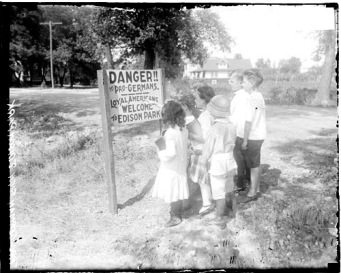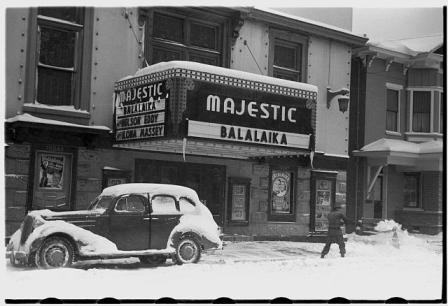Urban Childhood: 1930s-1950
German Village: Setting the Stage Before and during World War I, Germans-Americans became targets of hateful reactions from temperance groups and government propaganda (Rippley v). Prohibition ruined the neighborhood economy and “the brewery industry, a mainstay of the village, and its related industries, such as numerous shoe companies that supplied boots for workers, etc” (Conte 5) were destroyed.
Photographs 1 and 2:

________________________________________________________________________________
Urban Childhood and the Great Depression
Patricia Gusa never specifically mentions the depression in her memoirs. Born in 1932, her memory of that time period is probably hazy since she was so young. Even though the words “great depression” were never uttered by her, they were implicit in many of her childhood memories. Her family’s transient housing situation, method of cooking, chores, lack of automobile transportation, minimal medical care, and forms of entertainment all align with research about life during the Great Depression.
The Great Depression, 1929-1941, touched nearly every aspect of the life of children. Many children were no longer able to continue their formal education. Children’s wages were often necessary in order for the family to have the funds for food.
Photograph 3:
________________________________________________________________
Gender and Family Roles
A typical day in their home would be helping their father carry out the fireplaces ashes in big tubs, doing the dishes, ironing, and helping with laundry. When she came home from school, Patricia would take the clothes down from the line, shake them, fold them, and put them in a basket. When chores were finished, she and her siblings were to go to their bedroom to do their homework.
Patricia distinctly remembers the front porch of the American Four-Square house they lived in and how it served as a gathering place for her family. The porch represented a place where the family would connect and socialize with each other, but also with their neighbors and community. Even with the sense of community, Patricia recalls that her mother was hesitant about letting the girls socialize in the neighborhood like her brother did: “We mostly stayed at home. Mother was kind of funny about letting us girls out on the street.” The Gusa family didn’t go very many places, but they did visit the movie theater about once a week together. They would walk to the Victor or Parson’s Theater on Saturday or Sunday (if they were lucky they went both days) for the matinee show where popcorn and candy were a special treat they were allowed. Photographs 4-6:



__________________________________________________________________
World War II and Young Women in the Workforce
Though the war was over when Patricia was thirteen years old, the spirit of independence felt by teens (specifically young women) during this time was not lost on her. Patricia finished received her high school diploma in just two years and at the age of sixteen, in 1948, she entered the workforce at Prima Shoe Factory. Mintz and Kellogg noted that it was important for teens to develop a distinct identity that separated them from “the adult’s world war [and] the stress of family disruption” (167). Employment also put money in teenagers’ pockets for things like “buying their own magazines, purchasing records, [and] attending movies” (Mintz Kellogg 167). Photograph 7:

_________________________________________________________________________________
Sources
1. Conte, Jeanne. German Village. Woodland Park, Colorado: Mountain Automation Corporation, 1994.
2. Mintz, Steven and Susan Kellogg. Domestic Revolutions: A Social History of American Family Life. New York: The Free Press, 1988.
3. “Ohio Beer Signs.” OhioBreweriana.com. 2005. 18 February 2009 <http://www.ohio.>.breweriana.com/gallery/holdings/sign-hoster-factory.shtml
4. Rippley, La Vern J. The Columbus Germans. Indianapolis, Indiana: Max Kade German-American Center, 1998.
5. Patricia Gusa, oral history interview by Gayle Strege, cassette recording, Columbus, OH, 25 January 1999. On file with the German Village Society, Columbus, Ohio.
Photograph Sources
1. Title: [Children standing in front of an anti-German sign posted in Edison Park].
Photographer: Chicago Daily News, Inc.
Created/Published: 1917
Source/ Call Number: Library of Congress/ DN-0069264, Chicago Daily News Negatives Collection, Chicago Historical Society
2. Title: Advertisement for L. Hoster Brewing, Co. Columbus, Ohio.
Photographer: Unknown
Created/Published: Unknown
Source/ Call Number: OhioBreweriana.Com
3. Title: Seall, Lucy Yates: Elementary School Class
Photographer: Vernon Wollerman
Created/Published: Unknown
Source/ Call Number: The Ohio Historical Society/SC 5710, AL03560
4. Title: Child Helping with the Wash
Photographer: Everett Gracey
Created/Published: circa 1935
Source/ Call Number: http://www.photosofthegreatdepression.com/
5. Title: A Family Sitting on the Steps
Photographer: Department of Social Welfare, State of California
Created/Published: circa 1935
Source/ Call Number: California State Archives/F3580-69
6. Title: Shoveling snow away from the movie entrance, Chillicothe, Ohio.
Photographer: Rothstein, Arthur, 1915-
Created/Published: 1940 Feb.
Source/ Call Number: Library of Congress/ LC-USF33- 003472-M2
7. Title: Ohio Match Company Photographs
Photographer: Unknown
Created/Published: 1940-1960 circa
Source/ Contributor: Ohio Memory/Wadsworth Ella M. Everhard Public Library
